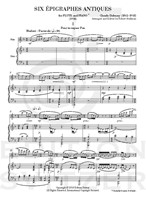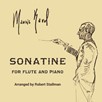
Six Épigraphes Antiques
Composer: Claude Debussy
Instrument: Flute and Piano
Level: Advanced
Published: 2018
Price: €25.00
Item details
-
Description +
-
Duration: 15. min.
Preface
Debussy’s lifelong attraction to the exotic—more specifically, to Greek mythology and Asian and African culture—is well known. His sense of fantasy is well reflected in these affecting reveries, the Six Épigraphes Antiques. Debussy composed this suite of pieces in 1914 in two versions: one for piano four-hands and another for two hands. It is interesting to note that the first four of the Épigraphes derive from his Chansons de Bilitis, written fifteen years earlier and set for spoken voice, two flutes and two harps—incidental music to poems by his friend Pierre Louÿs. What had originally been a composition of scattered musical fragments interspersed with recited poetry, was later transformed into a minor masterpiece for piano. To create a complete suite of pieces, Debussy composed the last two epigraphs afresh.
Taken all together, the Épigraphes can be experienced as six individual “primitive” expressions: an invocation (I and also the close of VI), an incantation (III), three dedications (II, IV and V) and a joyous prayer of thanksgiving (VI). The haunting Pour un tombeau sans nom and the brooding and sensuous Pour l’Égyptienne are deftly contrasted by the delicacy and subtle rapture of the remaining pieces. In the concluding movement, Debussy’s depiction of rain (the ostinato piano figure marked doux et monotone) cannot be matched for its simplicity and painterly realism—a stroke of genius from a great composer who hated being tagged as an “Impressionist”, although he is just that, and more.
Each of these expressive vignettes is ideally suited to the flute, an instrument that Debussy was particularly drawn to because of its primal nature, as well as its potential for subtlety and vocal intimacy. With the Six Épigraphes, we flutists can now expand our repertoire by adding another important work to Debussy’s two well-known compositions for flute: Syrinx and the Sonata for Flute, Viola and Harp.
“Toujours plus haut!” (Debussy’s personal credo)
Robert Stallman
July 12, 2018
Marblehead, Mass.
-
-
Instrumentation +
-
Flute and Piano
-
-
About the composer +
-
Claude-Achille Debussy (22 August 1862 – 25 March 1918) was a French composer. Along with Maurice Ravel, he was one of the most prominent figures associated with Impressionist music, though he himself disliked the term when applied to his compositions. He was made Chevalier of the Legion of Honour in his native France in 1903. Debussy was among the most influential composers of the late 19th and early 20th centuries, and his use of non-traditional scales and chromaticism influenced many composers who followed.
Debussy's music is noted for its sensory content and frequent usage of nontraditional tonalities. The prominent French literary style of his period was known as Symbolism, and this movement directly inspired Debussy both as a composer and as an active cultural participant.
-
-
Credits +
-
Front Cover graphics and layout: Gaia Gomes
Photo of Robert Stallman: Lisa Kohler
Engraving: Henrik Svitzer
Painting of Mozart: Joseph Lange
Printed in Copenhagen, Denmark
Copyright © Edition SVITZER
www.editionsvitzer.com
-









